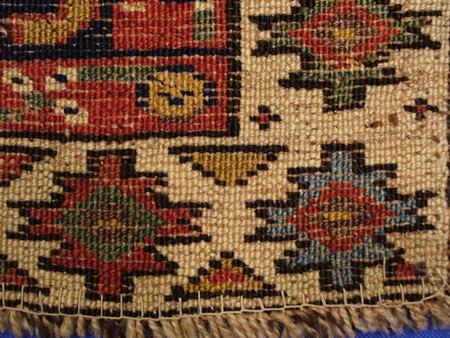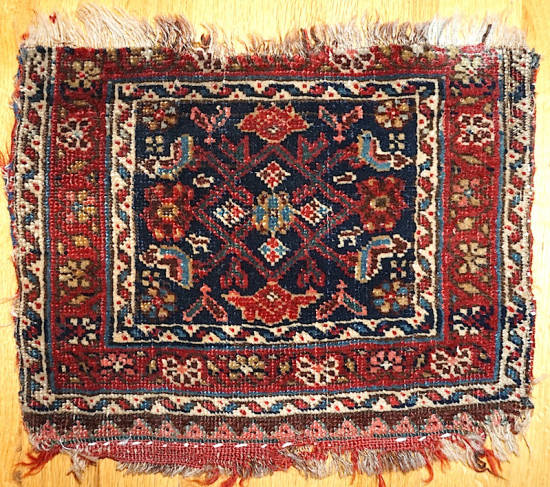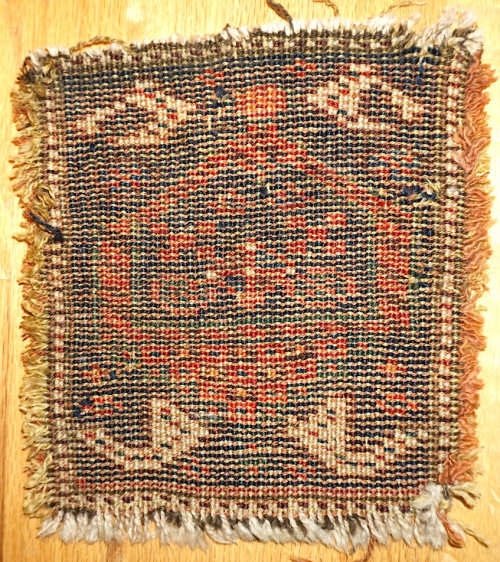| #1 Patrick Weiler |
October 28th, 2014 08:09 PM |
Serrated Leaf Motif
The
topic of the salon is whether or not there are Khamseh kilims
masquerading as Qashqai, Lur or Afshar kilims. Most rug authors and
researchers (Is that an oxymoron?) admit that the Khamseh wove kilims.
It's just that they don't really know what they look like or what to
look for. Some of the possible clues are dovetailed tapestry
construction, darker colors than Qashqai, darker warps and heavier feel.
The designs, however, mostly are so common to each other that it is not an easy call. We often look to rugs from a particular tribe for designs which then may have been transferred to their kilims, but this is mostly a dead end. The rug designs which seem to be most likely copied in kilims are those of the gabbeh. And the transfer may be the other way around, from kilim to gabbeh. My reasoning for this is that, until fairly recently (in rug years, anyway) SW Persian tribal kilims weren't very popular in the west. They were used domestically in SW Iran as covers over bedding at the back of the tent and has hangings. They made rugs to sell, but kilims for themselves. And gabbehs were similarly made for home use. So it seems that these domestic production designs were used in both of these formats, gabbeh and kilim, and the more formal, commercial rug designs had commercial cachet and a ready market.
Around a hundred years ago and more, kilims, especially Caucasian, did sell in the west. We have photos showing them in places such as Olana, the home of the Hudson River School painter Frederic Edwin Church. There is a Caucasian hanging as a portiere in this photo:

So, as opposed to looking for Khamseh rug designs which were also used in their kilims, let's look at pile designs which are common to multiple traditions.
One is the Bird on a Pole design, which we find all over the place.
Here is another one; the Serrated Leaf and Star Wars X-Wing design.


Put them together and you get rows of serrated leaves with rows of the X-wing between them.

The above is an Afshar carpet. It is probably over a hundred years old, a "squarish" 48" wide x 52" tall, (122x132cm) with the typical soft orange, brick red, three blues, green, brown, black and white colors. It has asymmetric knots, two wool wefts and depressed very light brown wool warp. The rows of serrated leaves are offset from each other by half a unit, giving the rug a dynamic, almost disjointed look.
Below is an Afshar bagface with the same design, 34" x 25" (84x64cm) and construction - but with that soft orange color weft and the same warp color as the rug, but a bit stiffer handle.

Next is a Khamseh version. It is more square, with darker coloration, 27"x25" (69x64cm) 8x8 knots per square inch and symmetric knots, no warp depression and a softer handle. The warps are very dark brown and the wefts are a dark reddish brown - as though a dark brown wool was dyed red.

Here is another Khamseh version of the same motif, but with a medallion in the center. It has a bit lighter brown warp, 27"x23' (69x59cm), 7x8 symmetric knots per square inch and no warp depression.

And to really mix things up, this probably later, modified version. It looks a bit younger than the other pieces.

This one is 27"x23" (69x59cm), with 6hx10v symmetric knots per square inch, two shots of very dark weft and light brown somewhat depressed warps. It has that Khamseh coloration, but more of an Afshar construction except for the symmetric knots. However, Murray Eiland, in his first tome on Oriental Rugs, writes "Formerly the knot could be used to distinguish village and tribal rugs, but this feature is less reliable now, as there has been extensive intermarriage (with local Persian villagers). The tribal rugs were traditionally woven with the Turkish knot, while the Persian villagers used the Persian knot."
This may, in fact, be a tribal Afshar with the Turkish knot.


I am not familiar with kilims in this design, but I am sure if there are any, someone will point them out. Again, typical rug designs were not often transferred to kilims. One reason is that the structural limitations of kilims lend them to have simpler, more rudimentary designs. And also, possibly, because these simple designs were quicker and easier to make.
Patrick Weiler
The designs, however, mostly are so common to each other that it is not an easy call. We often look to rugs from a particular tribe for designs which then may have been transferred to their kilims, but this is mostly a dead end. The rug designs which seem to be most likely copied in kilims are those of the gabbeh. And the transfer may be the other way around, from kilim to gabbeh. My reasoning for this is that, until fairly recently (in rug years, anyway) SW Persian tribal kilims weren't very popular in the west. They were used domestically in SW Iran as covers over bedding at the back of the tent and has hangings. They made rugs to sell, but kilims for themselves. And gabbehs were similarly made for home use. So it seems that these domestic production designs were used in both of these formats, gabbeh and kilim, and the more formal, commercial rug designs had commercial cachet and a ready market.
Around a hundred years ago and more, kilims, especially Caucasian, did sell in the west. We have photos showing them in places such as Olana, the home of the Hudson River School painter Frederic Edwin Church. There is a Caucasian hanging as a portiere in this photo:

So, as opposed to looking for Khamseh rug designs which were also used in their kilims, let's look at pile designs which are common to multiple traditions.
One is the Bird on a Pole design, which we find all over the place.
Here is another one; the Serrated Leaf and Star Wars X-Wing design.


Put them together and you get rows of serrated leaves with rows of the X-wing between them.

The above is an Afshar carpet. It is probably over a hundred years old, a "squarish" 48" wide x 52" tall, (122x132cm) with the typical soft orange, brick red, three blues, green, brown, black and white colors. It has asymmetric knots, two wool wefts and depressed very light brown wool warp. The rows of serrated leaves are offset from each other by half a unit, giving the rug a dynamic, almost disjointed look.
Below is an Afshar bagface with the same design, 34" x 25" (84x64cm) and construction - but with that soft orange color weft and the same warp color as the rug, but a bit stiffer handle.

Next is a Khamseh version. It is more square, with darker coloration, 27"x25" (69x64cm) 8x8 knots per square inch and symmetric knots, no warp depression and a softer handle. The warps are very dark brown and the wefts are a dark reddish brown - as though a dark brown wool was dyed red.

Here is another Khamseh version of the same motif, but with a medallion in the center. It has a bit lighter brown warp, 27"x23' (69x59cm), 7x8 symmetric knots per square inch and no warp depression.

And to really mix things up, this probably later, modified version. It looks a bit younger than the other pieces.

This one is 27"x23" (69x59cm), with 6hx10v symmetric knots per square inch, two shots of very dark weft and light brown somewhat depressed warps. It has that Khamseh coloration, but more of an Afshar construction except for the symmetric knots. However, Murray Eiland, in his first tome on Oriental Rugs, writes "Formerly the knot could be used to distinguish village and tribal rugs, but this feature is less reliable now, as there has been extensive intermarriage (with local Persian villagers). The tribal rugs were traditionally woven with the Turkish knot, while the Persian villagers used the Persian knot."
This may, in fact, be a tribal Afshar with the Turkish knot.


I am not familiar with kilims in this design, but I am sure if there are any, someone will point them out. Again, typical rug designs were not often transferred to kilims. One reason is that the structural limitations of kilims lend them to have simpler, more rudimentary designs. And also, possibly, because these simple designs were quicker and easier to make.
Patrick Weiler






 De-construction Zones
De-construction Zones






























